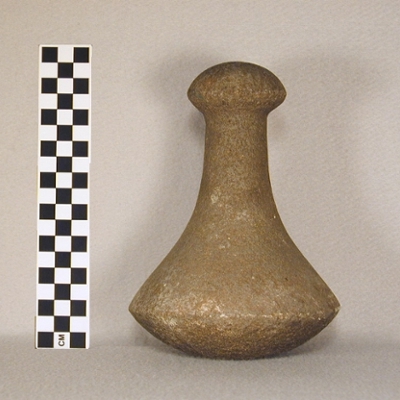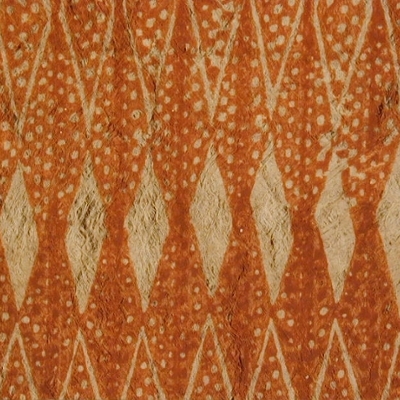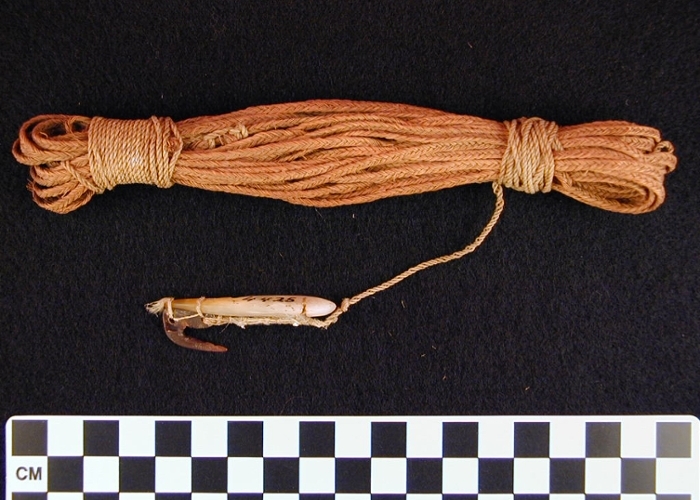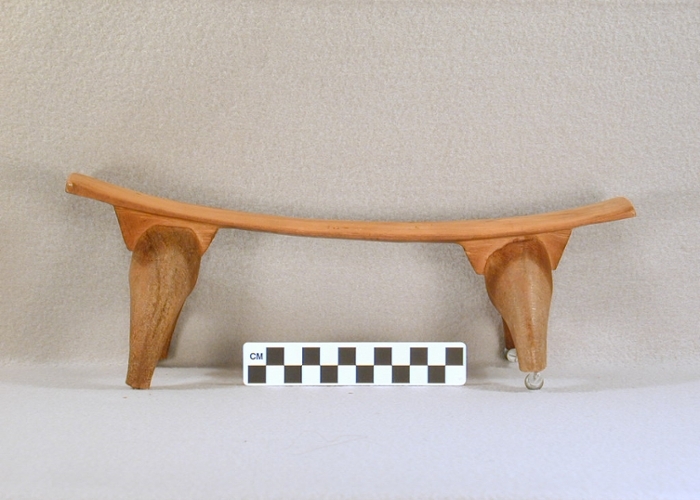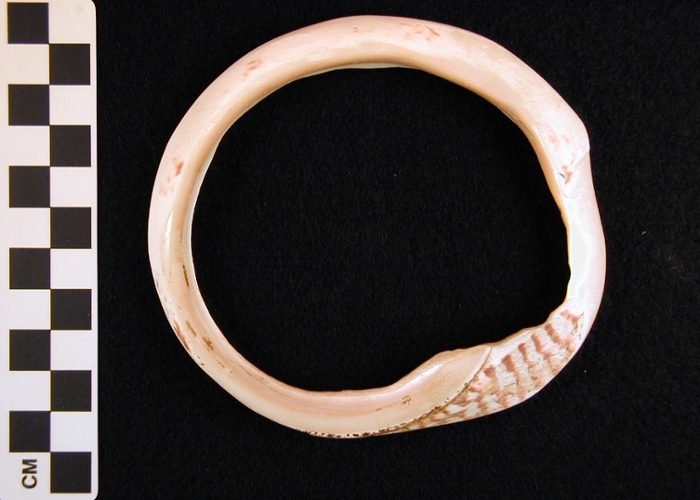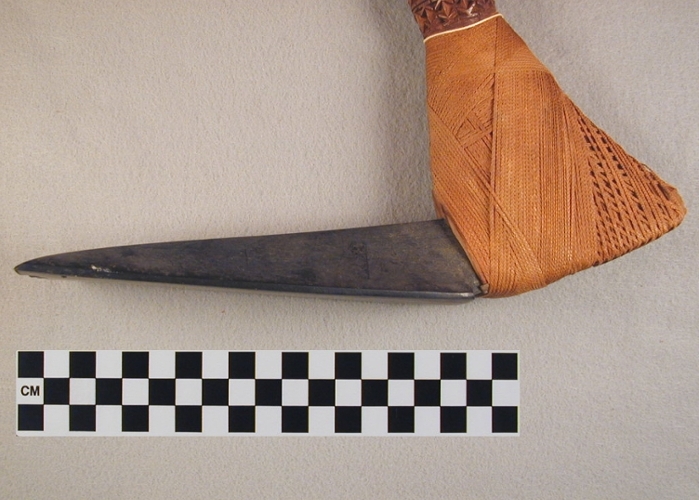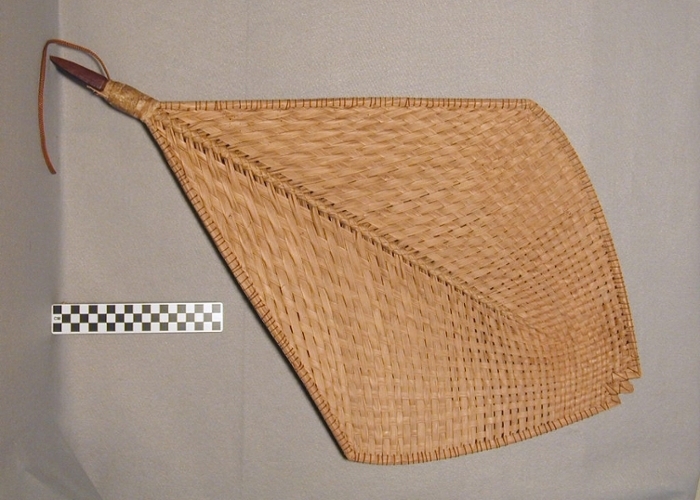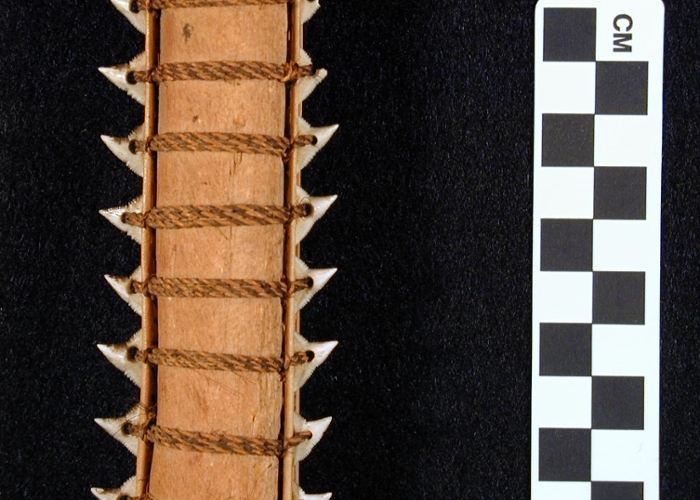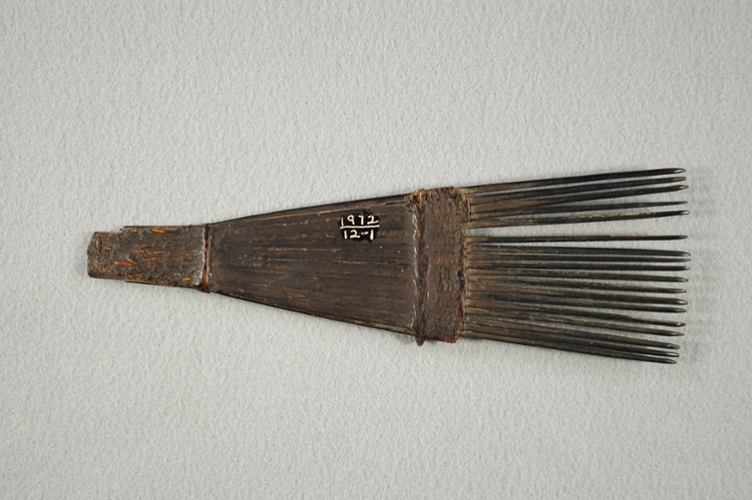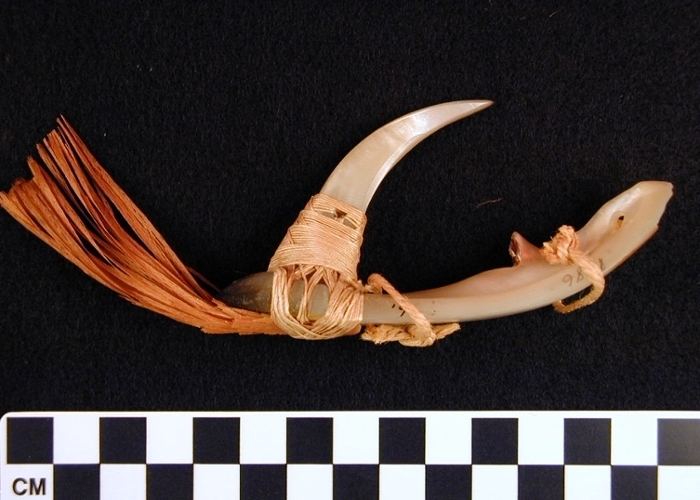Oceanic Collection
-
Poi Pounder
1940.2567.1
Hawaii, prior to 1940
Ex-collection Bishop Museum, Honolulu
20 cm highPoi, made from the corms of the taro plant (or kalo, in Hawaiian), was a staple food throughout Polynesia and continues to be culturally important today. In the traditional method, stone pounders (pohaku ku`i `ai) such as this one are used to mash the baked kalo against a wooden board, with water added in to create the desired consistency.
More infoIn Hawaiian culture, the kalo plant is considered an ancestor, the elder brother to the first Hawaiian. In return for care and respect, the elder brother provided sustenance for his younger sibling; thus growing kalo and making and eating poi are embodiments of the proper relationship between family members, as well as between the people and the land. -
Tapa Cloth
1870.394.1
Oceania, prior to 1870
Gift of the Missionary LyceumMany islands in the Pacific have traditions of making cloth from the bark of trees like the paper mulberry. This cloth is called by different names on different islands, but is commonly known in the west as tapa (or kapa in Hawaii). It is made from the inner bark, which is dried, soaked and beaten into thin sheets; several pieces can be glued or pounded together into larger sheets. It has been used for clothing, blankets, wall decorations and gifts marking important life events.
More infoWesleyan has several sheets of plain, undecorated tapa in its collections. The image shown here is a detail of one of the few pieces of decorated tapa cloth. -
Tapa Beater
1940.2565.1
Hawaii, prior to 1940
Ex-collection Bishop Museum, HonoluluThe Hawaiian version of tapa cloth is called kapa, and is known for its intricate, colorful designs. It is made in a two-stage beating process, with the bark being fermented in between beatings to help break down the tough fibers.
More infoThis type of square beater (i`e kuku) is used in the second stage-beating. The side with the wide grooves would be used first, followed by the narrow grooves and finally the patterned sides. The patterns vary by maker, and can in some cases form a recognizable "signature" design embossed into the cloth. After drying, kapa can be decorated via painting or stamping and even infused with scent. -
Fish Hook and Line
2014.7.1
Samoa, ca. 1838-1842
Ex-collection Smithsonian Institution No. 4425The tough, iridescent inner layer of certain mollusk shells known as "mother of pearl" was a popular material for fish hooks. This composite hook has a mother of pearl shank, tortoise shell point, and plaited plant fiber line. It likely would have been used to troll for fish from an outrigger canoe.
-
Headrest
1870.334.1
Fiji, prior to 1870
Gift of the Missionary LyceumHeadrests, as opposed to pillows, have been and continue to be used by many cultures around the world. They are useful in preserving elaborate wigs or hairstyles during rest. In Fiji, they were also important in preventing the head - considered the most sacred part of the body - from coming into contact with the ground.
More infoThe legs of this headrest are attached to the body via carved joints secured with plaited plant fiber lashings. They are broken off at the bottom, so it is unknown whether the piece originally sat on four feet or had a flat base. -
Shell Armband
1874.569.1
Fiji, ca. 1838-1842
Ex-collection Smithsonian Institution No. 4561This armband is made from the shell of a large sea snail of the genus Trochus. Armbands like these are more commonly associated with Papua New Guinea, but likely circulated throughout Melanesia via the extensive trade networks that existed long before American and European contact.
-
Ceremonial Adze
1870.374.1
Mangaia, Cook Islands, prior to 1870
Gift of the Missionary LyceumThis adze displays the characteristic black basalt blade, finely plaited coconut fiber sennit lashing and K-shaped carvings that made ceremonial Mangaian adzes (or toki) a favorite 19th-century collectible amongst sailors and missionaries. Examples of similar adzes are found in museums and private collections around the world.
More infoTraditionally, master craftsmen carved these shafts using shark teeth, shells or sharp stone. Post-contact, metal tools were also used. -
Woven Fan
1870.372.1
Mangaia, Cook Islands, prior to 1870
Gift of the Missionary LyceumThough coconut-leaf fans are common throughout Polynesia, 19th-century fans from the island of Mangaia are unique in their shape and manufacturing technique. By the early 20th century, this type of fan was reportedly obsolete, in part as a result of missionary activities on the island. A fan like this would have served to protect its bearer from both rain and sun, and may have indicated peaceful intentions when used in certain contexts.
More infoTe Rangi Hiroa (Sir Peter H. Buck), a Maori anthropologist, borrowed this fan from Wesleyan in order to study how it was made. He published his findings in the 1944 volume, Arts and Crafts of the Cook Islands. -
Shark Tooth Weapon
1870.376.1
Gilbert Group, Kiribati, prior to 1870
Gift of the Missionary LyceumThe people of the Gilberts used a variety of weapons edged with lethal shark teeth, from short daggers to long spears. Some had multiple blades or cross guards above the grip, much like a longsword. To defend against such weapons, they used armor made from knotted coconut sennit and rolls of coconut fiber.
Note how the teeth were individually drilled in order to lash them onto the shaft. Lashings were made of coconut sennit or human hair.
-
Hair Comb
1972.12.1
Likely Solomon Islands, late 19th century
Combs like this, called faa, were worn as hair ornaments by men in the Solomon Islands. The wooden teeth are lashed together and glued with plant resin. The upper part of the comb is decorated with a woven pattern of plant fibers. This is a fairly plain example. Faa are often decorated with elaborate multicolored woven patterns made of different (or dyed) grasses or shell pieces set into the resin.
-
Fish Hook and Lure
WUM Ethnology 1786
Micronesia, prior to 1901
Gift of Prof. W. N. RiceThis composite hook has a mother of pearl shank and hook, fringed plant fiber lure, and complex lashings of cotton string. This hook likely would have been used for offshore or open-water angling of pelagic fish like bonito.
